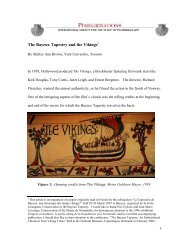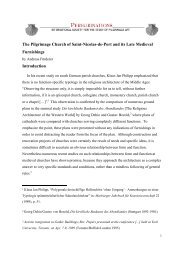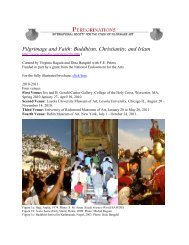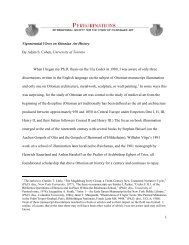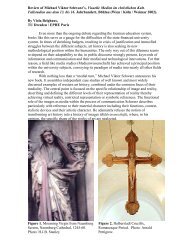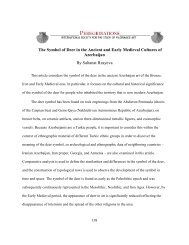The Bayeux Tapestry as a Religious - Peregrinations
The Bayeux Tapestry as a Religious - Peregrinations
The Bayeux Tapestry as a Religious - Peregrinations
You also want an ePaper? Increase the reach of your titles
YUMPU automatically turns print PDFs into web optimized ePapers that Google loves.
“monument to a Norman triumph” in an English hall would surely have aroused comment, and<br />
the mon<strong>as</strong>tic chroniclers adept at collecting gossip would surely have made mention of it.<br />
True to its dualistic nature, the <strong>Bayeux</strong> <strong>Tapestry</strong> h<strong>as</strong> had two lives: one religious, the<br />
other secular. From what little evidence is available we can see that the <strong>Tapestry</strong> w<strong>as</strong> made for<br />
a clerical patron who had sufficient resources to commission such lengthy embroidery. As for<br />
the <strong>Tapestry</strong> itself, it w<strong>as</strong> most likely embroidered by nuns sewing in a mon<strong>as</strong>tic workshop. <strong>The</strong><br />
<strong>Tapestry</strong> is worked on linen, a fabric long <strong>as</strong>sociated with the clergy. Also, only mon<strong>as</strong>tic<br />
houses would have had enough sheep to produce the huge quantities of wool required for the<br />
embroidery. Many of the designs and images in the <strong>Tapestry</strong> derive from sacred texts and<br />
manuscripts that may well have been found in the libraries of the mon<strong>as</strong>teries of St. Augustine‟s<br />
and Christ Church, Canterbury. Mingling with images that derive from Anglo-Saxon England<br />
and Scandinavia are those that show the influence of that most hieratic of societies, Byzantium.<br />
<strong>The</strong> <strong>Bayeux</strong> <strong>Tapestry</strong> h<strong>as</strong> always been <strong>as</strong>sociated with clerical buildings, first the Cathedral and<br />
now the museum, a former seminary. It can be said that the “secular” ph<strong>as</strong>e of the <strong>Tapestry</strong><br />
began with its near-demise during the French Revolution and the use made of it by Napoleon,<br />
English and French nationalists of the nineteenth-century, and then the Nazi occupying power.<br />
From the Enlightenment onwards a secular interpretation of the p<strong>as</strong>t h<strong>as</strong> become almost<br />
the standard view. <strong>The</strong> opposite w<strong>as</strong> the c<strong>as</strong>e during the medieval period: religion w<strong>as</strong> at the<br />
essence of life, and it w<strong>as</strong> also the prism through which lives and events were judged. Even the<br />
decorative elements in the <strong>Tapestry</strong>, such <strong>as</strong> the animals for example, had a moral purpose to<br />
them. History, art, literature: they were written or produced with a religious theme or moral<br />
behind them. Works such <strong>as</strong> the <strong>Tapestry</strong> should be seen within this moral, religious, context: it<br />
135



